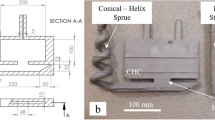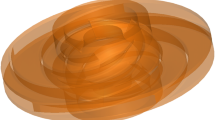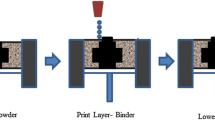Abstract
Additive manufacturing of sand molds and cores for metal castings, often called 3D sand-printing (3DSP), is an efficient “freeform” fabrication process that enables rapid production of sand metal castings. The ability to create highly complex molds and cores for advanced metal casting geometries via 3DSP provides unparalleled design freedom, particularly for low-volume production. However, there is a need to thoroughly understand the opportunities and restrictions of 3DSP in a systematic approach similar to well-established design guidelines for traditional sand casting. This study presents a knowledge-based design framework for 3DSP with the goal of developing new part design guidelines under such 3DSP framework. In particular, constrained topology optimization approach for the part redesign is developed for 3DSP. The presented design framework is compared with traditional sand-casting rules and validated through a case study on an existing metal component. Advantages of the developed 3DSP design framework are illustrated and validated through a case study where a 30% improvement in factor of safety and a 50% reduction in weight of a mechanical part is achieved. Other advantages, such as reduced lead time and production cost, are also observed. This research provides the first known investigation into systematic implementation of simultaneous constraints of 3DSP sand-casting rules mechanical strength through the integration of topology optimization and novel design rules to castings via 3D-printed molds. 3DSP also eliminates multiple design constraints in conventional mold-making and core-box fabrication. Findings from this study can be applied for a wide range of alloy systems, part geometries and loading conditions for sand castings in industrial applications.





















Similar content being viewed by others
References
B.P. Conner et al., Making sense of 3-D printing: creating a map of additive manufacturing products and services. Addit Manuf 1, 64–76 (2014)
ASTM, Standard Terminology for Additive Manufacturing Technologies, in ASTM F2792-10e1 (ASTM International, West Conshohocken, PA, 2012)
T. Wohlers, Wohlers Report 2016: Gloabal Reports (Wohlers Associates Inc., Belgium, 2016)
T. Campbell, C. Williams, O. Ivanova, B. Garrett, Could 3D Printing Change the World? Technologies, Potential, and Implications of Additive Manufacturing, Strategic Foresight Report (Atlantic Council, Washington, DC, 2011). Retrieved December 1, 2017 from http://www.atlanticcouncil.org/publications/reports/could-3d-printing-change-the-world
Y. Huang, M.C. Leu, J. Mazumder, A. Donmez, Additive manufacturing: current state, future potential, gaps and needs, and recommendations. J. Manuf. Sci. Eng. 137(1), 014001 (2015)
S.L. Ford, Additive manufacturing technology: Potential implications for US manufacturing competitiveness. J. Int. Commerce Econ. 6, 40 (2014)
B. Dutta, F.H.S. Froes, The Additive Manufacturing (AM) of Titanium Alloys, in Titanium Powder Metallurgy (Butterworth-Heinemann, Boston, 2015), pp. 447–468
W.E. Frazier, Metal additive manufacturing: a review. J. Mater. Eng. Perform. 23(6), 1917–1928 (2014)
W.A. Haviland, Maya Settlement Patterns: A Critical Review (Middle American Research Institute, Tulane University, New Orleans, LA, 1966)
M. Chhabra, R. Singh, Rapid casting solutions: a review. Rapid Prototyp. J. 17(5), 328–350 (2011)
E.S. Almaghariz et al., Quantifying the role of part design complexity in using 3D sand printing for molds and cores. Int. J. Metalcast. 10(3), 240–252 (2016)
G. Manogharan, Hybrid Manufacturing: Analysis of Integrating Additive and Subtractive Methods (Industrial Engineering, North Carolina State University, Raleigh, NC, 2014)
L.A. Schmit, Structural Design by Systematic Synthesis, in Proceedings of the 2nd Conference on Electronic Computation (ASCE, New York, 1960), pp. 105–122
O. Sigmund, K. Maute, Topology optimization approaches. Struct. Multidiscip. Optim. 48(6), 1031–1055 (2013)
M.P. Bendsøe, O. Sigmund, Material interpolation schemes in topology optimization. Arch. Appl. Mech. 69(9), 635–654 (1999)
J.-H. Zhu, W.-H. Zhang, L. Xia, Topology optimization in aircraft and aerospace structures design. Arch. Comput. Methods Eng. 23(4), 595–622 (2016)
M. Zhou, R. Fleury, Y.-K. Shyy, H. Thomas, J. Brennan, Progress in Topology Optimization with Manufacturing Constraints, in Proceedings of the 9th AIAA MDO Conference AIAA-2002-4901, 2002
X. Wang et al., Topological design and additive manufacturing of porous metals for bone scaffolds and orthopaedic implants: a review. Biomaterials 83, 127–141 (2016)
S. Yang, Y.F. Zhao, Additive manufacturing-enabled design theory and methodology: a critical review. Int. J. Adv. Manuf. Technol. 80(1–4), 327–342 (2015)
Z. Doubrovski, J.C. Verlinden, J.M. Geraedts, Optimal design for additive manufacturing: opportunities and challenges, in ASME 2011 International Design Engineering Technical Conferences and Computers and Information in Engineering Conference, (American Society of Mechanical Engineers, 2011), pp. 635–646
K.A. James, G.J. Kennedy, J.R. Martins, Concurrent aerostructural topology optimization of a wing box. Comput. Struct. 134, 1–17 (2014)
L. Krog, A. Tucker, M. Kemp, R. Boyd, Topology Optimization of Aircraft Wing Box Ribs, in 10th AIAA/ISSMO Multidisciplinary Analysis and Optimization Conference, Albany, NY, 2004, pp. 1–11
J.W. Chang, Y.S. Lee, Topology optimization of compressor bracket. J. Mech. Sci. Technol. 22(9), 1668–1676 (2008)
P. Wu, Q. Ma, Y. Luo, C. Tao, Topology optimization design of automotive engine bracket. Energy Power Eng. 8(04), 230 (2016)
X. Li, L. Wang, Based on topology optimization method the cab mount bracket lightweight design. Appl. Mech. Mater. 152–154, 1292–1297 (2012)
J. Seppälä, A. Hupfer, Topology Optimization in Structural Design of a LP Turbine Guide Vane: Potential of Additive Manufacturing for Weight Reduction, in ASME Turbo Expo 2014: Turbine Technical Conference and Exposition (American Society of Mechanical Engineers, 2014), pp. V07AT28A004–V07AT28A004
R. Rezaie, M. Badrossamay, A. Ghaie, H. Moosavi, Topology optimization for fused deposition modeling process. Proc. CIRP 6, 521–526 (2013)
W. Carter et al., The GE Aircraft Engine Bracket Challenge: An Experiment in Crowdsourcing for Mechanical Design Concepts, in Solid Freeform Fabrication Symposium (University of Texas at Austin, Austin, Texas, 2014), pp. 1402–1411
V. Maranan, T.W. Simpson, T. Palmer, C.J. Dickman, Application of Topology Optimization and Design for Additive Manufacturing Guidelines on an Automotive Component, in ASME 2016 International Design Engineering Technical Conferences and Computers and Information in Engineering Conference (American Society of Mechanical Engineers, 2016), pp. V02AT03A030–V02AT03A030
Q. Xia, T. Shi, M.Y. Wang, S. Liu, A level set based method for the optimization of cast part. Struct. Multidiscip. Optim. 41(5), 735–747 (2010)
R. Tavakoli, P. Davami, Optimal riser design in sand casting process by topology optimization with SIMP method I: poisson approximation of nonlinear heat transfer equation. Struct. Multidiscip. Optim. 36(2), 193–202 (2008)
Z. Li, Z. Mao, W. Li, Optimization design of riser based on particle swarm algorithm. Zhuzao (Foundry) 54(2), 176–178 (2005)
L. Harzheim, G. Graf, A review of optimization of cast parts using topology optimization: II—topology optimization with manufacturing constraints. Struct. Multidiscip. Optim. 31(5), 388–399 (2006)
G. Allaire, F. Jouve, G. Michailidis, Casting Constraints in Structural Optimization Via a Level-Set Method, in 10th World Congress on Structural and Multidisciplinary Optimization (HAL.archives-ouvertes.fr, Orlando, Florida, 2013)
J.P. Leiva, B.C. Watson, I. Kosaka, An Analytical Directional Growth Topology Parameterization to Enforce Manufacturing Requirements, in Proceedings of 45th AIAA/ASME/ASCE/AHS/ASC Structures, Structural Dynamics, and Material Conference, Palm Springs, CA, 2004
A.R. Gersborg, C.S. Andreasen, An explicit parameterization for casting constraints in gradient driven topology optimization. Struct. Multidiscip. Optim. 44(6), 875–881 (2011)
K.-T. Zuo, L.-P. Chen, Y.-Q. Zhang, J. Yang, Manufacturing-and machining-based topology optimization. Int. J. Adv. Manuf. Technol. 27(5), 531–536 (2006)
J.K. Guest M. Zhu, Casting and Milling Restrictions in Topology Optimization Via Projection-Based Algorithms, in Proceedings of the ASME 2012 International Design Engineering Technical Conference & Computers and Information in Engineering Conference, Chicago, IL, USA, August, 2012, pp. 12–15
O. Schmitt, J. Friederich, S. Riehl, P. Steinmann, On the formulation and implementation of geometric and manufacturing constraints in node–based shape optimization. Struct. Multidiscip. Optim. 53(4), 881–892 (2016)
Q. Xia, T. Shi, M.Y. Wang, S. Liu, Simultaneous optimization of cast part and parting direction using level set method. Struct. Multidiscip. Optim. 44(6), 751–759 (2011)
M. Langelaar, Topology optimization of 3D self-supporting structures for additive manufacturing. Addit. Manuf. 12, 60–70 (2016)
A.T. Gaynor, J.K. Guest, Topology Optimization for Additive Manufacturing: Considering Maximum Overhang Constraint, in 15th AIAA/ISSMO Multidisciplinary Analysis and Optimization Conference, Atlanta, GA, 2014, pp. 16–20
M. Leary, L. Merli, F. Torti, M. Mazur, M. Brandt, Optimal topology for additive manufacture: a method for enabling additive manufacture of support-free optimal structures. Mater. Des. 63, 678–690 (2014)
D. Brackett, I. Ashcroft, R. Hague, Topology Optimization for Additive Manufacturing, in Proceedings of the Solid Freeform Fabrication Symposium, Austin, TX, 2011, vol 1, pp. 348–362
E. Komi, P. Kokkonen, J. Virta, P. Puukko, S. Metsä-Kortelainen, Simulation, Optimisation and Design of a 3D Printed Sand Mould for a Cast Metal Component (VTT Technical Research Centre of Finland Ltd, 2016). Retrieved December 1, 2017 from http://www.vttresearch.com/Documents/Factory%20of%20the%20future/3D%20printing/Komi_NAFEMSpresentation_SandcastAM.pdf
ExOne, Webinar: A Case Study in Optimizing Casting Design Using 3 D Printing (AFS Metalcasting Television, 2017). Retrieved December 1, 2017 from http://www.afsinc.org/multimedia/MCTVDetail.cfm?ItemNumber=19145
W. Wang, H.W. Stoll, J.G. Conley, Rapid Tooling Guidelines for Sand Casting (Springer, New York, NY, 2010)
ASM International, Casting Design and Performance (ASM International, Materials Park, OH, 2009)
D. Snelling, Q. Li, N. Meisel, C.B. Williams, R.C. Batra, A.P. Druschitz, Lightweight metal cellular structures fabricated via 3D printing of sand cast molds. Adv. Eng. Mater. 17(7), 923–932 (2015)
D. Snelling, C. Williams, A. Druschitz, A Comparison of Binder Burnout and Mechanical Characteristics of Printed and Chemically Bonded Sand Molds, in SFF Symposium, Austin, TX, 2014
P.M. Hackney, R. Wooldridge, 3D sand printing for automotive mass production applications. Int. J. Rapid Manuf. 6(2–3), 134–154 (2017)
I. Ferguson, M. Frecker, T.W. Simpson, C.J. Dickman, Topology Optimization Software for Additive Manufacturing: A Review of Current Capabilities and a Real-World Example, in ASME 2016 International Design Engineering Technical Conferences and Computers and Information in Engineering Conference (American Society of Mechanical Engineers, Charlotte, NC, 2016), pp. V02AT03A029–V02AT03A029
M.P. Bendsoe, O. Sigmund, Topology Optimization: Theory, Methods, and Applications (Springer, New York, NY, 2004)
SolidThinking, SolidThinking Inspire (Altair Engineering, Troy, MI, 2016)
Alcoa Fastening Systems & Rings, Airplane Bearing Bracket Challenge (2015). Retrieved January 12, 2016 from https://grabcad.com/challenges/airplane-bearing-bracket-challenge
Y. Hahn, J.I. Cofer, Study of Parametric and Non-Parametric Optimization of a Rotor-Bearing System, in ASME Turbo Expo 2014: Turbine Technical Conference and Exposition (American Society of Mechanical Engineers, Düsseldorf, Germany, 2014), pp. V07AT28A001–V07AT28A001
T. Seifert, H. Riedel, Mechanism-based thermomechanical fatigue life prediction of cast iron. Part I: models. Int. J. Fatigue 32(8), 1358–1367 (2010)
Acknowledgements
This research work is funded by America Makes project: Additive Manufacturing for Metal Casting (AM4MC). We would like to thank The University of Northern Iowa Metal Casting Center (UNI MCC) for the 3D printing of sand molds and casting of the product. We also want to thank the Penn State FAME laboratory for assistance with the post-processing of cast parts.
Author information
Authors and Affiliations
Corresponding author
Rights and permissions
About this article
Cite this article
Wang, J., Sama, S.R. & Manogharan, G. Re-Thinking Design Methodology for Castings: 3D Sand-Printing and Topology Optimization. Inter Metalcast 13, 2–17 (2019). https://doi.org/10.1007/s40962-018-0229-0
Published:
Issue Date:
DOI: https://doi.org/10.1007/s40962-018-0229-0




